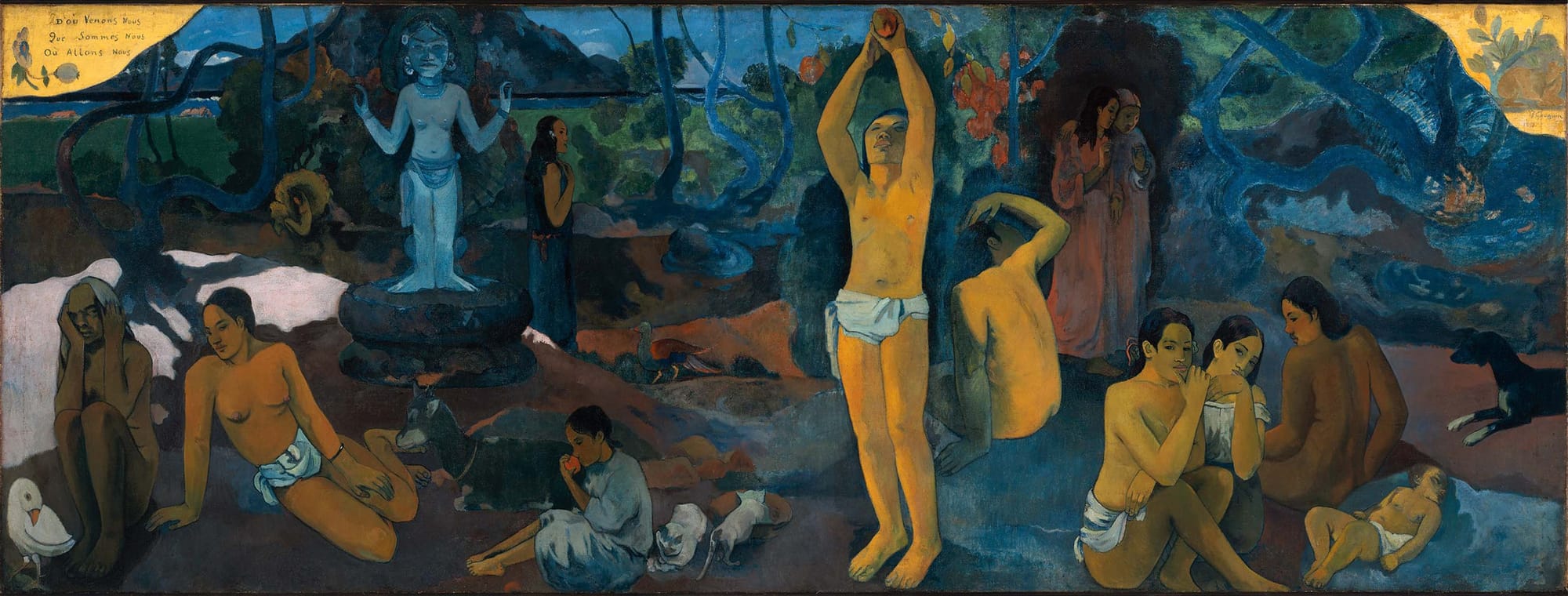How to change the past
To progress from ignorance to knowledge, we require this intermediary moment where we posit the truth as lost and in need of recovery. This loss is precisely what catalyzes our search, and the result of this search is the production of the truth.

To change the past, we must change the future.
History, like a sentence, is transformed by the addition of one simple word.
The present demands of us only that we add a new sign to the growing chain.
What will we add to the sentence and what new voice will be made to speak?
Life is like a sentence
Would Paul Gauguin's life still have been "good" if he had been a mediocre painter?
In his essay "Moral Luck," Bernard Williams traces the way that the moral value of a specific human life has a necessarily retrospective quality to it. All the trials, pain, and confusion of the journey are at once transformed in light of the achievements which redeem and transfigure all that has gone before them.
He uses the example of Paul Gauguin (1848-1903), a French painter famous for abandoning his life and his family in France to go live in a hut in Tahiti for the final decade of his life. It was during this period of his life spent living in French Polynesia that Gauguin produced some of his most enduring works.

Williams wants us to see that, from the point where Gauguin stood, his life decisions and his experiences up to that point still held an indeterminate value – depending on whether his paintings were truly great, his life could be deemed either an overall failure or it could be considered a great success. What the events of his life "were" remained in a very real sense undetermined yet.
Thus, this valuation of what a life is operates only in the retrospective. In retrospect, Gauguin's entire life may become good or bad depending on whether all the disparate threads of his life can be cinched together with a symbol which will thereby produce a brand new picture of the whole.
Meaning, much like the story of a human life, functions like a sentence.
Each word we add to a sentence retroactively changes the meaning of everything which had gone before it, thereby bringing into existence an entirely new whole.
If you suspend the meaning of the sentence as a whole and instead read the sentence one word at a time, you'll notice that the individual words in a sentence can sustain an indeterminate cloud of meanings right up until a specific word comes along which seems to "suture" those meanings which were left open previously.
Once the right word arrives, the previous words mean something new, something which they did not mean before, and something which they now mean only because of the retroactive work of the new addition to the sentence.
The sentence fragments anticipate their future meaning because of their incompleteness (they make us lean in, expecting more), and thus they hold open the possibility of many different meanings, but then certain suturing points in the sentence arrive which then foreclose those other meanings, and the sentence collapses into a definite range of interpretation. Until the right sign arrives in the signifying chain, the words remain constitutively open about what they will be.
Here is the mechanism we are focusing on – each time a new sign is added to a sentence, each prior word is retroactively changed to "mean" what it now means within the newly emergent and transformed whole.
This is the logic of the signifier (the sign), and these exact mechanics of the meaning-making operation in language indicate for us the deeper structure of human thinking in general.
The truth is structured like a fiction
We can see now what Jacques Lacan meant when he said that truth has the structure of a fiction.
Lacan was not making the superficial nihilistic claim that truth is a fiction in the sense of its being illusory or unreal, but rather his words mark for us how the truth appears only through a retroactive movement whereby the achievement of the truth in the present always reaches back into the past to posit the conditions of its own appearance.
When the truth arrives, the past is transformed into a preparation for the arrival of that truth which has now appeared. Truth performs this narrative feat whereby it appears to have always already been there, just waiting for us to discover it. Having been achieved, the truth feels inevitable to us, as though everything which came before was all moving towards this singular truth.
This is, strictly speaking, an illusion. Was the meaning always there from the beginning, simply waiting to be unearthed? In some sense, yes, but not in the sense which we take it to be.
We have already shown how the meaning of each prior moment is essentially indeterminate, that is, lending itself to many possible future transformations, and thus every reality's truth is inextricably dependent on the future signs which will enter the chain of moments to either foreclose or actualize certain meanings.
The truth does not exist as an artifact which was buried or waiting to be found, as though we are seeking to dig up a lost city to reveal its hidden splendor. Rather, at each moment, truth emerges as a new construction which at once hides itself under the artifice of a "re-discovery" or a "re-membering."
Consider this passage from Lacan's seminar II in which he talks about the theme of re-discovery or "reminiscence" in human knowledge (the added emphasis is mine):
What distinguishes Freud here from all the authors who have written on the same subject... is the idea that the object of the human quest is never an object of rediscovery, in the sense of reminiscence.
The subject doesn't rediscover the preformed tracks of his natural relation to the external world. The human object always constitutes itself through the intermediary of a first loss. Nothing fruitful takes place in man save through the intermediary of a loss of an object...
The subject has to reconstitute the object, he tries to find its totality against starting from I know not what unity lost at the origin."
Lacan's Seminar II, page 136
I believe that this is one of Lacan's great insights. Note how he even models this very point through the way he presents the ideas in the quote above – by passing off his own insight as having originally belonged to Freud, Lacan shows how the human always constitutes themselves with reference to some prior loss.
What does Lacan mean by this "intermediary of a first loss?" He means that in order for us to find the truth, we must first assume that it has been lost. We must place the rabbit into the hat before we can pull it out, so to speak. The discovery of a new totality can only take place if we start from the standpoint of trying to uncover its original unity which now seems lost from our perspective.
We must hide the truth in order to find it
But why perform this circuitous action? This two-fold movement of hiding the rabbit in order to find it seems to be the basic structure of how human thought arrives at genuine advancements. We must be pushed forward, not pulled.
In order to progress from the state of ignorance to the fullness of knowledge, we require this intermediary moment where we posit the truth as lost and in need of recovery. This loss of the truth is precisely what catalyzes our search, and the result of this search is the production of the truth. This new truth then covers over its tracks by retroactively positing its own necessity into the past circumstances which lead up to its emergence.
Plato's story of the soul's reminiscence provides the perfect example here (and Lacan likely has it in mind in the quote above). Plato spins a yarn that our souls once had acquaintance with the True, the Good, and the Beautiful, but with the soul's descent into the realm of bodies and materiality, we now suffer from a foggy memory. The process of arriving at knowledge is thus for Plato a re-membering of what we once knew but have since forgotten.
This is why we are liable to misunderstand what is happening in therapy.
Psychoanalysis focuses on repression and childhood memories in order that we might bring about an encounter with the truth of what we are. Through this confrontation with the truth of ourselves, we hope to be changed. However, the archaeological language used here serves to cover over the productive mechanics which are at play in the patient's work.
The patient continues to come into therapy because they believe that the therapist knows the truth and they will help the patient find it. However, the reality is that the therapist does not know the truth about the patient. Rather, it's the patient's belief that the therapist knows the truth which causes the patient to speak, think, and struggle until the truth finally appears.
The analyst cannot know the patient's truth ahead of time, both because they are not the patient but also because this truth does not, strictly speaking, exist yet.
The analyst knows that it is the patient who knows the truth, but this inchoate knowledge exists in an abstract and repressed manner which requires extensive labor to mediate itself through the signs and symbols which make up the patient's life-world. This cloud of indeterminacy cannot yet be called truth in any sense.
This truth which appears through the patient's wrestlings is not a simple uncovering of the truth which was always hiding their waiting to be discovered, but is rather a present achievement – a new word in the sentence – which has the power to change everything that came before it.
In the clinic then, the patient is trying to find the next word to put into their sentence. They are a sentence, and while they may hold worlds within themselves, they only get one chance to speak and one truth to live.
This piece has been brewing for a while, but this week it seemed to all come together at once. I've been really excited to share it with you. I hope that it stimulates some new thoughts for you by allowing you to see the world a little differently than you did before.
As a reminder, I released a new episode of Samsara Audio this week – you can listen or watch my conversation with Quinn Whelehan in which we talk about the encounter between Eastern and Western philosophy, especially comparing Nagarjuna's four-fold logic with Hegel's three-fold dialectics.
Thanks for reading Samsara Diagnostics this week! As always, I welcome any comments or feedback that you'd like to share with me! You can always email me at samsara[at]skiff.com or use the contact form on my Contact page.
